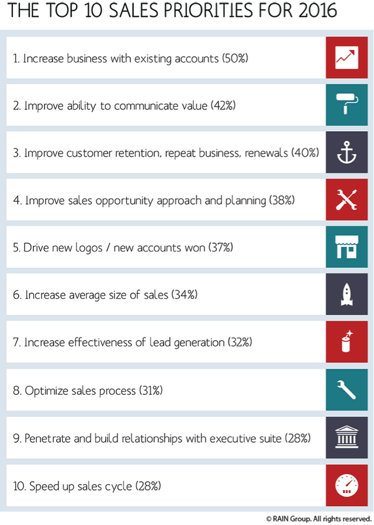
Ten Keys to Achieving This Year’s Top Sales Priorities
The RAIN Group Center for Sales Research has released a sales performance study featuring interviews with 472 sales executives, and the results are illuminating. Among other things, the study asked participants, who represent companies with sales forces ranging from 10 to 5,000-plus sellers, to rank their priorities for 2016.

 In the accompanying analysis, one of the study’s authors, Mike Schulz, names sales process as one of the critical means for achieving all of these priorities: “Having a systematic process to managing all sales opportunities—from everyday sales to the most important opportunities—is critical for sales growth and success.”
In the accompanying analysis, one of the study’s authors, Mike Schulz, names sales process as one of the critical means for achieving all of these priorities: “Having a systematic process to managing all sales opportunities—from everyday sales to the most important opportunities—is critical for sales growth and success.”
The full report further supports Schultz’s point. It compares competencies in eight areas against sales performance at the same 472 organizations, and finds a strong correlation between Top Sales Performers and the implementation of a world-class process. “The Rest” of the interviewed organizations were more likely to describe emerging or ad hoc processes.
Schulz speculates that part of the reason some organizations haven’t implemented an effective sales process has to do with the short-term pressures of the typical sales position. Quarterly quotas and commission-based compensation combine to drive a culture in which it’s difficult to look past this month’s numbers. Such short-term thinking creates pressure to skip process development, which can be time-consuming, and instead to focus on hiring superstar salespeople. It also encourages individual sales people to skip steps in whatever process does exist, in order to close deals faster.
To make matters worse, traditional sales technologies, such as Salesforce.com, don’t provide the tools to reinforce a sales process, track progress, or gain insights from win/loss analysis at the process level.
In such an environment, it can be challenging to look forward far enough to implement a consistent sales process – and even harder to find or build a technology system to support it, but there’s no doubt that it’s necessary to success.
If any of the top ten sales priorities are on your list for 2016, here’s how you can leverage sales process to achieve them:
1. Increase business with existing accounts. Left to their own devices, salespeople tend to focus on new leads and ignore the wealth of opportunity that exists in current accounts. Make sure your sales process includes a systematic approach for identifying and pursuing opportunities with existing customers.
2. Improve ability to communicate value. This is particularly important in markets where commoditization drives salespeople to discount products and services in order to close deals. A strong sales process provides salespeople with the steps necessary to consistently demonstrate value, differentiate the offering, and avoid discounting.
3. Improve customer retention, repeat business, and renewals. Again, without a consistent process, it’s easy to forget the importance of existing and previous customers. An established sales process can prompt sales people to follow up and continue to provide value to customers after the sale, and thus increase the value of existing customers.
4. Improve sales opportunity approach and planning. Having a solid process in place reminds salespeople and sales managers of the right times to review opportunities, and the steps to take to be ready for the next stage in the sales cycle, based on the buyer’s place in the journey.
5. Drive new accounts won and average size of sales. RAIN’s report clearly reveals that the difference between Top Performers on new sales and “The Rest,” is a well-implemented process to which everyone is held accountable.
6. Increase effectiveness of lead generation. Some salespeople seem born with an instinct for finding good prospects, but relying on these superstars to drive lead generation is a short-term and unsustainable tactic. A good sales process defines effective lead generation activities, and helps sales people qualify prospects early to avoid wasting time on the wrong leads, while guiding them to invest appropriately with high quality leads.
7. Optimize Sales Process. In addition to mapping the sales process, leading organizations build mechanisms into the system that enable learning from each sales cycle. They use this information to optimize the sales process based on real-time feedback and win/loss analysis.
8. Penetrate and build relationships with executive suite. Strong relationships between salespeople and executives drive better win rates and larger deals. Make sure your sales process maps out the steps salespeople must engage in to identify, connect with, and build rapport with these important decision makers.
9. Speed up the sales cycle. A well-designed and optimized sales process will shorten sales cycles by keeping salespeople focused on the tasks and activities that make a difference, and helping them move the prospect steadily through the process toward the close.
10. Improve new employee onboarding. According to RAIN’s report, fast and effective onboarding training is the biggest differentiator between Top Performers and “The Rest.” A well-established process with the right training, tools, and reinforcement helps to get new salespeople on board and delivering results faster.
 For such a process to be effective, it must be set up within a system that reinforces the process at each point, a methodology if you will (and do read our whitepaper comparing all the leading methodologies). Membrain provides the technology backbone for such a system.
For such a process to be effective, it must be set up within a system that reinforces the process at each point, a methodology if you will (and do read our whitepaper comparing all the leading methodologies). Membrain provides the technology backbone for such a system.
Instead of merely tracking activities, Membrain bakes the process into the CRM itself so that the correct process is reinforced at every step, progress can be tracked and effectively coached, executives can access insights into how the process is performing, and salespeople can access exactly the right resources to support them at each stage of the process.
Achieving higher sales performance through process implementation doesn’t happen overnight, but it can happen quickly when you have the right resources, training, and tools at your disposal. Read this case study to see how one manufacturing company increased profitability by 50% within the first year of process implementation.
Then read “Six Ways to Create an Actionable Sales Process” for guidance on devising a process to help you get there.
What are your sales priorities for 2016? What’s your plan to get there?

By George Brontén
George is the founder & CEO of Membrain, the Sales Enablement CRM that makes it easy to execute your sales strategy. A life-long entrepreneur with 20 years of experience in the software space and a passion for sales and marketing. With the life motto "Don't settle for mainstream", he is always looking for new ways to achieve improved business results using innovative software, skills, and processes. George is also the author of the book Stop Killing Deals and the host of the Stop Killing Deals webinar and podcast series.
Find out more about George Brontén on LinkedIn







